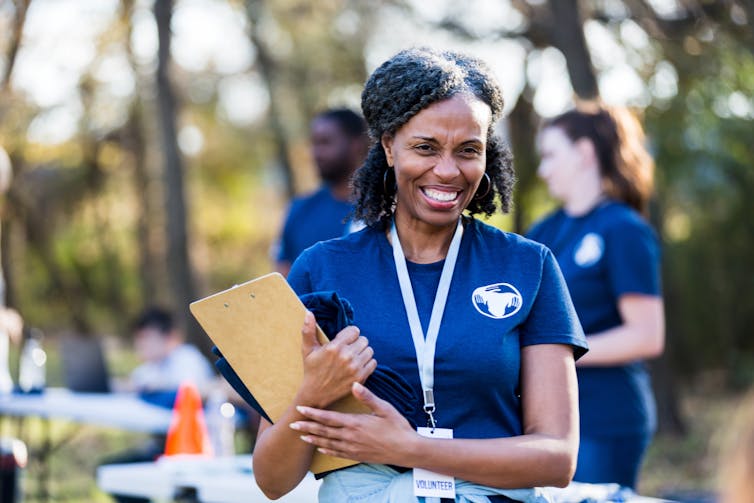Many Americans celebrate philanthropic donations to privately run institutions of all kinds – from Boys and Girls Clubs to church-sponsored charities – while bemoaning big government.
But they may not realize how heavily nonprofits, especially those providing services for people in need, rely on the public sector for their budgets.
Beginning as early as the 1930s and accelerating during the 1960s, many important social services in the U.S. have been largely funded by government but delivered by privately run nonprofits operating job training programs, health clinics, child development centers, etc.
By the late 1970s, nonprofit social service agencies received almost half their funding from local, state or federal governments. That share gradually grew to over 60% by 2010 and has remained near that level since then.
In my new book, “Democracy’s Hidden Heroes: Fitting Policy to People and Place,” I examine the promise and pitfalls of these partnerships between government agencies and nonprofits. By relying heavily on privately run organizations to deliver social services, the government can employ fewer people, reducing the size of its bureaucracy and payroll.
But these partnerships can flounder. Ironically, a key reason is one of the most widely used strategies for improving and tracking the impact of these services, commonly called “results accountability.”
Funding and flexibility
Here’s how results accountability works:
Government agencies specify the desired outcomes of a program or policy initiative they’re funding. They then hold the nonprofits implementing that program accountable for meeting these predetermined goals. For example, workforce and job training programs are asked to report the percentage of their clients who become gainfully employed and retain their jobs after six months or a year.
At the same time, nonprofits are given the flexibility to decide how to achieve the goals. When projects are completed, nonprofits report not only on what they did with the money but what they achieved.
Results accountability may sound like an ideal way to marry the political ideals of a strong government with community engagement. Government leaders gain a way to manage local service providers and to hold them accountable; nonprofits get the funding and the flexibility required to meet the needs of the communities they serve; and legislators can assess the return on investment of government-funded programs.

A failure to align
In practice, results accountability requires three different things that seldom align and are often in short supply.
First, the goals must be clear and agreed upon by all parties. This is particularly difficult in collaborative partnerships where goals often diverge or shift over time.
Second, there must be a way to measure outcomes so they can be reported. But outcome data can be difficult or costly to obtain.
Finally, there must be a way to use evidence regarding outcomes to adjust policy and programs. This step is often missing entirely in systems that are awash in numbers but have little time for careful deliberation on what the numbers mean.
In the course of three decades of evaluating grant-funded programs, I have never encountered a situation where all three of these conditions were met at the same time.
Rigid bureaucratic requirements
I have interviewed hundreds of nonprofit directors and other local leaders who have had to contend with results accountability requirements. In “Democracy’s Hidden Heroes,” I share their stories of being caught between rigid bureaucratic requirements and unique community circumstances.
These people work in places where bureaucracy and community networks meet and often collide. They tell stories about receiving funds from multiple government agencies with conflicting rules and requirements. They lament preset performance targets that get in the way of promised local flexibility. They worry that grants will lead them to abandon their core mission as they attempt to satisfy funder goals.
Some grant objectives are so broad, such as promoting a healthy community, that they leave nonprofits wondering how to pick and choose among a dizzying number of potential indicators of success. Sometimes small but important community improvement efforts, such as stream cleanup days or street beautification projects, are expected to be measured by sophisticated outcome indicators that are a bad match for the straightforward work being done.
Nonprofit leaders caution that these metrics do not capture the most important parts of their work and are often costly to collect. They repeatedly explain that reporting requirements take valuable staff time away from helping their clients. In some cases, this reporting and other red tape consumes about two workdays a week.
Government agencies and the nonprofits they fund both feel pressure to highlight achievements. They often avoid mentioning what does not work due to the pressure they feel to look successful, motivated by the need to secure future funding. This leads to a tendency in which they fail to learn from mistakes and make corrections that actually improve the system and help clients.

Strategies to get things done
More often than you might expect, many nonprofits do achieve their goal of meeting client needs despite all that red tape.
This is because of the often hidden, yet vitally important, role played by the people I consider to be the hidden heroes who work for nonprofits and other community organizations.
Many of the stories I heard were about workarounds, sidesteps and informal agreements that enabled government and nonprofit partners to get things done.
Hidden heroes learn to straddle the distinct worlds of government bureaucracy and community-based services. They become conversant in both cultures and two different ways to talk about this important work. They encourage government experts to see themselves as community members and urge community members to be viewed as experts on their own situations.
When a funder’s rules do not fit their circumstances, these hidden heroes of social services negotiate alternatives or find workarounds that fit better.
Assessing the entire system
The government and nonprofits are, and have long been, partners in providing social services. But my decades of research have made it clear that these partnerships could do a better job of meeting the needs of low-income people and their communities.
More funding would help, after decades of declining social spending and growing inequality. The U.S. spends less on social services than most higher-income countries.
It also matters how that money is spent.
One of my key findings is that people who need social services often receive them from multiple agencies, some of which are nonprofits and some of which are government-run. How well those agencies collaborate with one another influences the degree to which they successfully assist their shared clients. For example, it makes a difference whether the referral process between agencies works smoothly or if local agencies are duplicating programs while some needs aren’t being met at all.
Government grants usually fund and evaluate programs one at a time. While that is often necessary, it is also important to assess the entire system and to fund community planning and network development activities so that agencies can work better together to serve client needs.
Metrics that assess outcomes can be helpful, but my research shows why the government, as well as foundations and other private funders, should carefully consider and limit how many things social service nonprofits must measure to meet a grant’s requirements.
Finally, my research makes clear that that most government policies and programs need to be adapted to the particularities of local communities or of individual clients. The hidden heroes of nonprofit social services organizations play an important role in making that happen.

